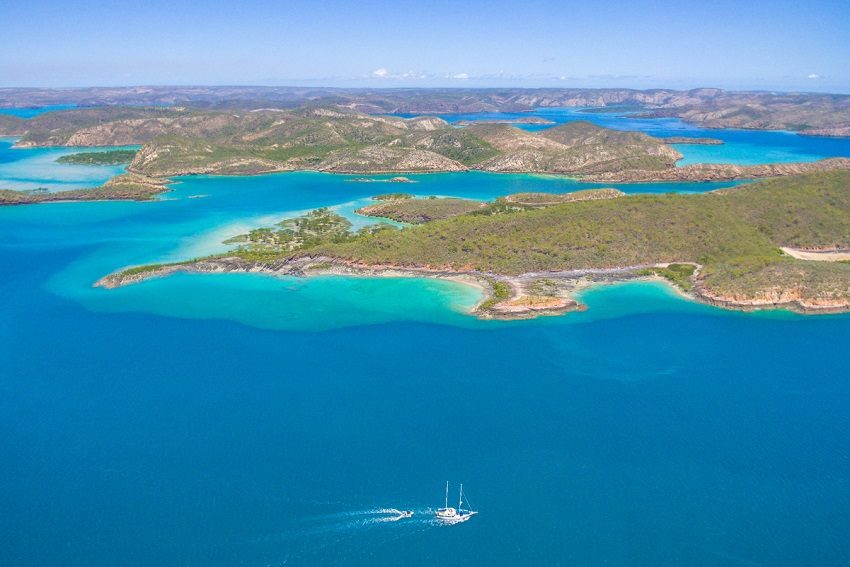Cruising the Kimberley Coastline

Between shucking wild oysters and navigating waterways hemmed by red cliffs and mangroves, Alexis Buxton-Collins embraces the beauty of the mostly untouched and entirely exquisite Kimberley coastline.
The vast Kimberley region is one of the most remote parts of Australia, and travelling there is as expensive and time-consuming as many overseas trips. But it’s that very isolation that has helped to preserve this incredible wilderness, and makes it such a special place to visit.
It’s a land that demands to be explored and an increasing number of travellers are doing just that, but on the coast north of Broome it’s possible to escape the crowds even during peak season. There the savannahs of dry cane grass are replaced by a turquoise ocean lapping at the base of towering sandstone cliffs. Mammoth tides expose entire reefs and islands before plunging them back beneath the surface while banks of mangroves on the shore hide the entrances to creeks, bays and inlets beyond count.

It’s not an easy place to visit — like everywhere in the Kimberley, it takes time and money — but local tour provider Ahoy Buccaneers provide an affordable way to cruise this largely untouched coast. Eschewing the ultra deluxe approach of their pricier competitors, the 24-metre yacht The Oceanic has room for 19 guests willing to go with the flow of a more informal trip.
Setting out from Cygnet Bay after a rough two-hour bus ride, we get our first taste of the strongest tidal currents in the world as the Oceanic makes slow progress against an incoming tide. It’s why our progress relies on the engine rather than sailing power, but our attention is soon diverted as we spot a rapacious flock of birds in a feeding frenzy.
Below the surface a school of tuna are rounding up bait fish and soon we’re racing across the waves in one of the vessel’s dinghies, trying to add sashimi to the dinner menu. Despite the mass of fish we come up empty, a theme that is set to continue during a trip that reveals my primary maritime skill to be hooking sharks.

Fortunately, there’s still time to collect some fresh seafood as we hop ashore on a secluded beach. Beneath the dusky flowers of a sticky kurrajong (also known as Kimberley Rose) we search below the high tide line for rock oysters that we pry open and eat fresh.
Over the course of the next week, we’re at the whim of tides and weather patterns as we plot a haphazard course through the narrow channels separating the thousand odd islands of the Buccaneer Archipelago. These are the exposed ridges and peaks of a submerged mountain range, and though much of the land is scrubby and sere at the end of the dry season, patches of vivid green pandanus palms thrive where the water table is shallow. At high tide it’s possible to penetrate deep inland up the swollen creeks, the dinghies passing between thick beds of mangroves that provide vital breeding grounds for fish and a hiding place for the army of invisible crocodiles we’re constantly warned about.
Our first destination is one of Australia’s more unusual attractions. The horizontal waterfalls are the result of a bottleneck created by parallel ridgelines with tiny gaps that form the twin entrances to Talbot Bay. Because the tidal movements are restricted by these openings, water backs up on one side and a series of rapids forms. These swiftly turn into churning maelstroms of white water before reversing direction after six hours.

Raft Point, where we spend two evenings, is one of the most beautiful spots on the entire trip. Onshore, a short walk leads to an impressive rock art gallery while the sheer cliffs of the headland and surrounding islands provide a spectacular vista, our own maritime Monument Valley.
The rest of the trip passes in a relaxed blur of steep beaches, swollen creeks and freshwater swimming holes, while the ability to catch sharks grows more pronounced by the day.
At Silver Gull Creek, we visit one of the most remote houses in the country on a bluff overlooking a bend in the creek. A croc suns himself on the pontoon opposite while we explore with one of the crew members, Scotty. He tells tales of passing yachties and past residents as we relax in a rainwater tank that has been converted into an idyllic swimming hole, well clear of the crocs.

His local connections are to prove vital when we find ourselves becalmed the next day. It’s a comical situation — the engine has run out of fuel — but with no fixed itinerary it does little to dampen our spirits. Several passengers head off in a tender to try their luck fishing while the rest retire to a nearby beach.
Later, as we approach Koolan Island to refuel, the landscape changes. Dramatic cliffs in vibrant shades of red and brown are replaced with the uniform grey slopes of open-cut mines. There are no tussocks of spinifex in this denuded landscape, and the squat, bulbous shapes of boab trees and tenacious rock figs that thrust their roots into tiny cracks and crevices are also missing.
The stark intrusion of industry on the landscape is a shock, but it also acts as a reminder of what has made the trip, and the Kimberley, so special.
The writer was a guest of Ahoy Buccaneers